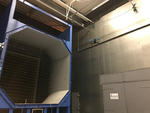Aerodynamic Modeling Identification for Multi-Rotor Drones
 A tested quadrotor flying in the wind tunnel.
A tested quadrotor flying in the wind tunnel.
Aerodynamic effects of a multi-rotor drone are complicated. Although most of the time, a multi-rotor drone operates at a near-hovering condition where these aerodynamic effects are negligible, a high-speed applicable aerodynamic model is “always” welcomed for analyzing drone performance, designing agile flight tractories, and boosting controller performance.
This research project aims at developing aerodynamic models of a quadrotor using system identification approaches. To this end, we have conducted flight tests of a quadrotor in a large scale wind tunnel, namely Open Jet Facility at TU Delft. As a first research outcome, we have obtained a high-speed applicable gray-box model capturing dominant aerodynamic effects (such as blade-flapping, thrust variation) as well as minor effects (e.g., rotor-body wake interactions, aerodynamic moments).
After designing some novel fault-tolerant flight controllers, we have conducted a wind tunnel flight test of a high-speed spinning quadrotor with the complete failure of one or two rotors. Using these flight data, we have identified a more generalized aerodynamic force/moment model, with very few parameters. This model can be either applied to a quadrotor without failure or with the complete loss of a propeller.
